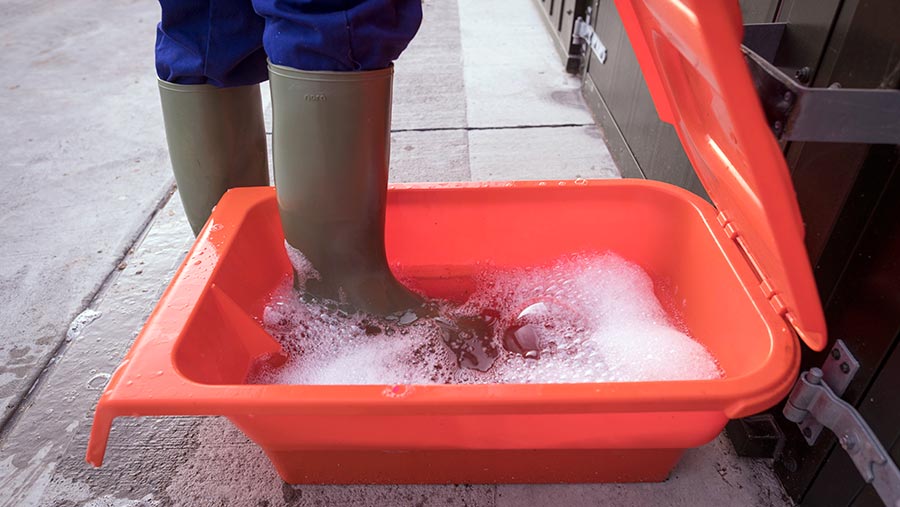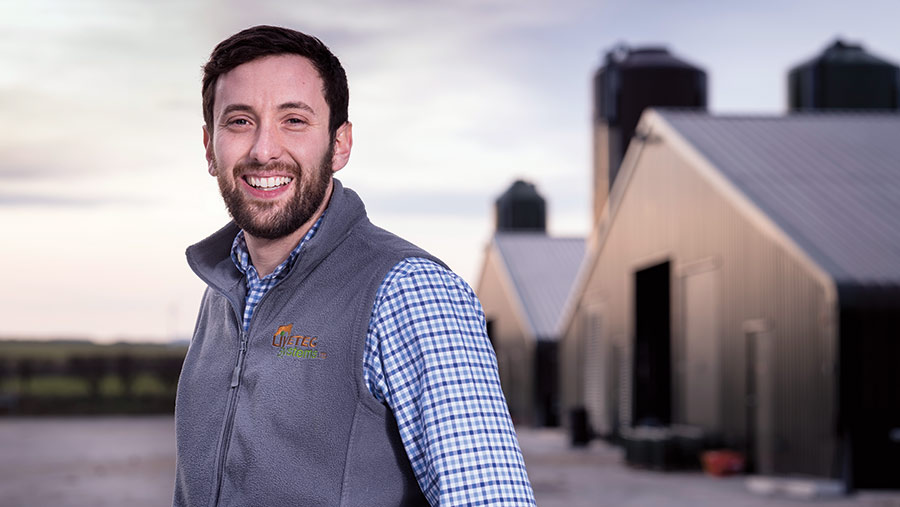Avian influenza: One farm’s robust plans to combat the threat
 A single point of entry can be crucial to control movements © Jim Varney
A single point of entry can be crucial to control movements © Jim Varney Chief among the threats to any poultry business in the UK is the incursion of avian influenza (AI). It is possible to reduce the risk of it finding its way into flocks, but impossible to prevent entirely and, once infected, the effects can be devastating.
It is something at the forefront of Soanes Poultry farms manager Mark Ireland’s attention, as he is in the late stages of developing a contingency plan with specialist Livetec Systems.
While the business has never been struck by avian influenza, planning for the worst will go a long way to mitigate the damage that an outbreak in the area might cause.
“We first tried to create the plan in-house, but it’s a much bigger job than you realise,” Mr Ireland explains. “It has to be more than just a few sheets of paper that you take out when an auditor visits.”
See also: Avian influenza: The signs and symptoms
Farm facts: Soanes Poultry
- Family-owned business based in the Yorkshire Wolds
- In operation for more than 70 years
- Produces chicken for a range of restaurants, butchers, farm shops and food service companies in Yorkshire and beyond
Control
Those farmers with just a basic outline of what to do in the event of a bird flu outbreak in their area – or even on their farm – might want to consider for a moment the impact an infection may have on their business.
The Animal and Plant Health Agency (Apha) is tasked with “stamping out” AI and other notifiable infections, such as Newcastle disease, and takes a rigorous approach.
After a farm vet confirms a suspected case of AI, it is a legal requirement to notify Apha, which will have a vet on site within hours to begin investigations.
After further tests on the birds, that government vet will then need to determine if and how any infection may have spread – every movement of people, feed or any other material both on and off the premises over the previous 21 days will be scrutinised.
Not having paperwork up to date is no excuse, according to Livetec operations manager Neal Samet, who explains that civil servants will call “day and night” until they have the information they need.
He recalls one farm struck down by AI that had 156 such movements over the preceding three weeks – clearly a mammoth task to compile if records are not up to scratch.

Livetec’s Neal Samet © Jim Varney
Restricted movement
As soon as investigations are under way, movement of people, feed, birds, eggs and litter will be restricted on the site, and if it is strongly suspected that AI is present nearby farms can immediately fall under similar restrictions.
If and when an infection is confirmed, a “protection zone” is established and all movements of poultry within 3km of the infected site must be licensed.
It is therefore crucial to understand how best to manage such a scenario, and Soanes Poultry is an example of just how much thought needs to go into contingency planning.
The business has nearly a million bird places, mostly on owned farms all within a few miles of the processing plant and headquarters at Middleton-on-the-Wolds, near Driffield, in the East Riding of Yorkshire.
It is in the middle of an ambitious programme of expansion, with Mr Ireland having recently concluded a “root and branch” review of farm management with the aim of reducing antibiotic use dramatically.
He says the result is that medicines are now being used only infrequently and when absolutely necessary. In 2018, a £1.6m investment in the processing facility increased capacity by 20%, and a number of older sheds are being razed and replaced with larger, modern units to meet demand.
While most poultry farms are dedicated broiler sites, Soanes runs a number of grain and potato operations close by, as well as free-range poultry.
Nearby is one of the UK’s largest game shoots, and the entire region is relatively packed with pig and poultry farms – all things to consider when drawing up a risk assessment for the business.
“If a nearby site goes down, it could put our entire business in a control zone – we have to have contingencies in place,” Mr Ireland explains.
Biosecurity top tips
To ensure good biosecurity, all poultrykeepers should:
- Minimise movement in and out of bird enclosures.
- Clean footwear before and after visiting birds.
- Clean and disinfect vehicles and equipment that have come into contact with poultry.
- Keep areas where birds live clean and tidy, and regularly disinfect hard surfaces such as paths and walkways.
- Humanely control rats and mice.
- Place birds’ food and water in fully enclosed areas protected from wild birds, and remove any spilled feed regularly.
- Keep birds separate from wildlife and wild waterfowl by putting suitable fencing around outdoor areas they access.
- Keep a close watch on birds for any signs of disease and report any very sick birds or unexplained deaths to your vet.
Risk assessment
Livetec was engaged to draw up that contingency plan and make recommendations to change the business where necessary.
Livetec technical director Julian Sparrey says: “The first thing we go out and do is a risk assessment, and the size of that depends on how many sites there are.
“With 10 sites and a processing facility, there are a lot of interactions to consider across the company.”
Each farm and the processing plant are assessed “as they sit within the landscape”, he explains. Proximity to other poultry, areas attractive to wild birds or Apha’s “higher risk areas”, which are published on its website each year, are all reviewed.
“We then look closer at the site and consider things that might cause problems, like footpaths, adjoining businesses, and then finally the actual poultry unit and how it is ringfenced from any other operation going on.”
The reason for that ringfencing is straightforward: if a farm comes down with avian influenza, any movement must take place under a specific licence from Apha.
That is the case even if testing to confirm a negative result is required, which can take up to 10 days. Over that time egg collections, muck movements and feed deliveries are all severely hampered.
“Anything you do regularly on that farm is restricted while you are under suspicion – and you remain responsible for the welfare of the birds over that time. You need to know what needs to get on and off farms well in advance,” explains Mr Sparrey.
Risk and response
The Livetec plans are weighty documents; part of the reason for thata is they recognise that maintaining the highest standards when the risk of avian influenza is not at its greatest is not always a realistic prospect for busy farm managers.
So a standard is set, with a higher tier of biosecurity and control introduced in the winter months, when risks of infection increase.
The final part is a plan for managing a farm during an outbreak, considering the additional measures that Defra would expect to contain disease.
“Other farms have had things like wedding venues, gymnasiums, farm shops and bed & breakfasts as part of their enterprise – you must consider how all these businesses are going to be impacted by restrictions being placed on your farm.”
For Soanes Poultry, a number of recommendations to adjust gates and boundaries were made where shared farm entrances collected grain and gave access to poultry. Even a farm manager’s house can fall foul of the rules: “Imagine having to apply for a licence to allow your children to go to school – or to return home afterwards,” says Mr Samet.
Sinage and entry points
Understanding the boundaries of a farm, how it interacts with other parts of the business and what procedures are in place will go a long way in reducing the stress of what is probably the most challenging scenario a farmer can face.
Part of the process is working to isolate poultry farms as a single site, have clear signage and a single point of entry. “If the correct point of entrance is not clear, people will just wander round the site until they find someone,” says Mr Sparrey.
The broader business must be considered as well. If pigs are kept close to the site, there should be a physical barrier between the two sides to discourage staff from walking between them – that can help control the risk of salmonella contamination as well as reduce AI risk.
Finally, the relatively higher risk that free-range poultry imposes must also be considered in the context of the broader business.
Insurance
Free-range egg producers that are members of the British Free Range Egg Producers Association are insured against the cost of secondary cleansing and disinfection (the government picks up the cost of an initial clean) to the value of £50,000 for each member, up to £1m.
Additional coverage can be bought to cover the loss of stock, and business continuity.
Underwriters would expect to see a detailed risk assessment before offering coverage.
A number of other insurers offer policies to poultry farmers with a range of protection available.
Processing
Processing facilities can be placed under restrictions, too. If a farm is found to be positive for avian influenza and birds from the site have gone to slaughter, then it too will need to be investigated.
The licensing rule that applies to farms can equally apply to processing facilities, so separating the entrance for live birds, as well as the staff that handle them, can keep disruption to a minimum.
“It’s about mitigating the whole risk as much as possible – and if the worst happens it’s making the business ready to react if necessary,” says Mr Samet.
Fact file: Livetec Systems
- Secialises in the business of bird flu, alongside other research projects.
- Has managed aspects of most avian influenza outbreaks that have hit Britain over the past few years
- Retains a contract with the British Poultry Council to undertake culling in the event that it is required on one of its member’s farms
- Cotinngency planning is available as a one-off consultancy or an ongoing subscription.
Avian influenza in the UK
Poultry producers will remember the anxiety felt in the winter of 2016-17, when 10 outbreaks of highly pathogenic H5N8 avian influenza hit sites across Lincolnshire, Lancashire, Suffolk, Carmarthenshire, Yorkshire and Northumberland.
As a result, a Housing Order was made, which required all free-range birds to be kept indoors.
While there have been isolated detections of AI in wild birds since, the risk remains – birds are still discovered across Europe with the disease, and the UK is an important overwintering ground for many bird species.
